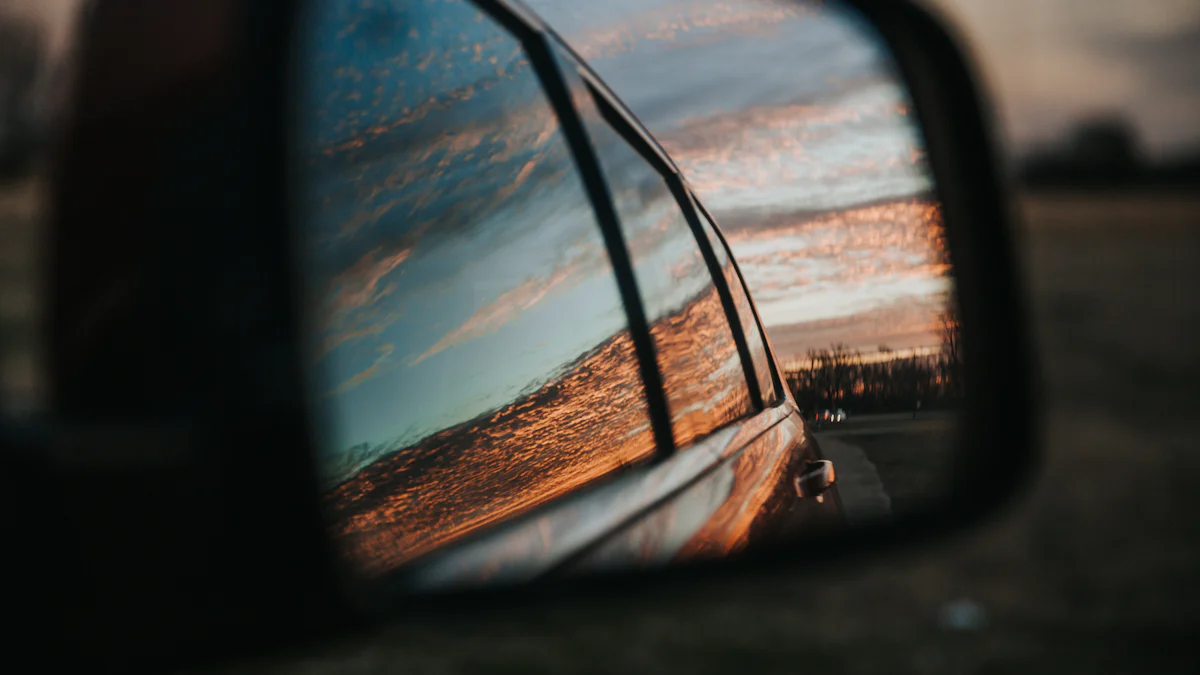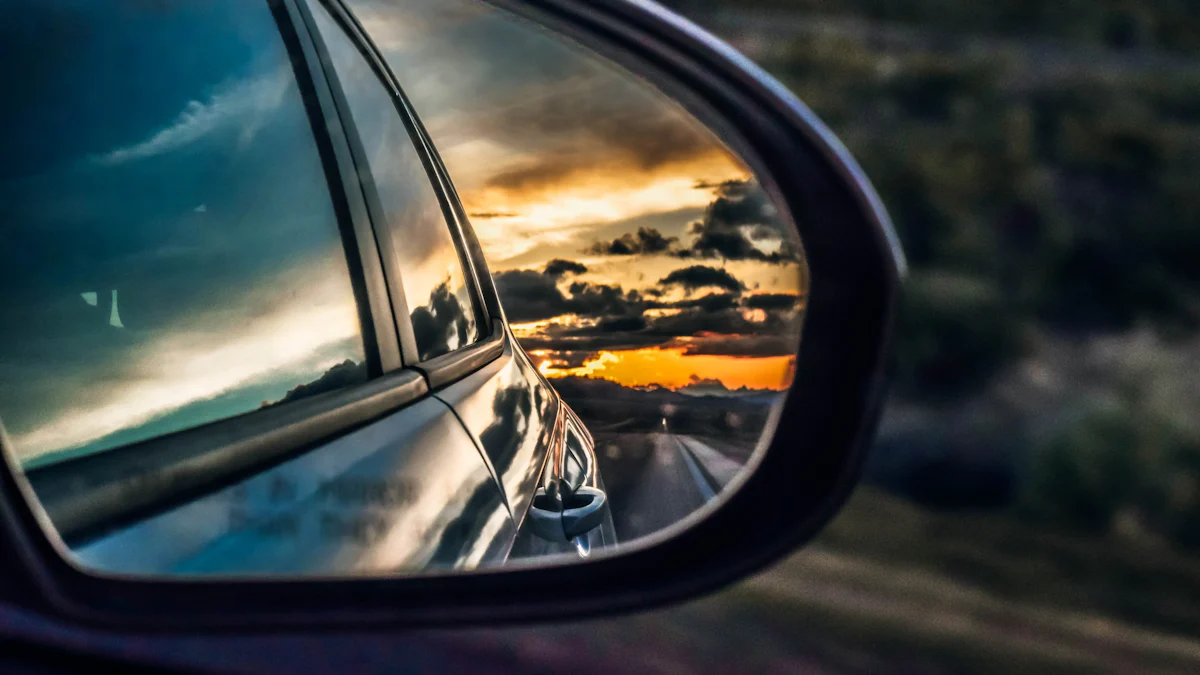
Have you ever wondered how drivers keep track of what’s happening behind them? That’s where the rearview mirror comes in. It’s one of the most important safety tools in any vehicle. By glancing at it, you can monitor traffic, spot fast-approaching cars, and avoid potential dangers. It’s also a lifesaver when parking or reversing in tight spots. A properly adjusted rearview mirror even reduces blind spots, giving you a clearer view of your surroundings. Whether you’re driving a sedan or using a towing mirror for Ford Ranger 2012+ Black, this simple tool plays a huge role in keeping you safe on the road.
In the mirror industry, innovation continues to enhance the functionality and design of these essential components, ensuring that drivers have the best possible visibility.
Tip: Make it a habit to check your rearview mirror regularly while driving. It’s a small action that can prevent big accidents.
Key Takeaways
- Look at your rearview mirror often while driving. This habit helps avoid crashes and keeps you alert to traffic.
- Adjust your mirrors correctly to see better. This lowers blind spots and makes lane changes and parking safer.
- Keep your mirrors clean and fix broken ones. Clean mirrors help you see clearly and follow safety rules.
Purpose and Benefits of a Rearview Mirror

Enhancing Visibility and Awareness
Have you ever noticed how much easier driving feels when you can see what’s happening behind you? A rearview mirror gives you that extra set of eyes. It provides a clear view of the road behind your vehicle, helping you stay aware of your surroundings. Whether it’s a car speeding up or a cyclist approaching, the mirror keeps you informed.
Here’s why it’s so important:
- It helps you monitor traffic behind you, especially when slowing down or stopping.
- Convex mirrors, often used in rearview mirrors, can reduce blind spots and improve visibility.
- Studies show that rear-mounted mirrors could prevent up to 49% of backover crashes.
By simply glancing at your rearview mirror, you can make smarter decisions and avoid surprises on the road.
Role in Accident Prevention
Did you know that something as simple as checking your rearview mirror can save lives? It’s true! Rearview mirrors play a huge role in preventing accidents. For example, they help you spot fast-approaching vehicles, giving you time to react. They’re also crucial for avoiding rear-end collisions when you’re slowing down.
Take a look at this table to see how effective rearview mirrors and other technologies are in preventing backover crashes:
| Technology | Percent of Backover Crashes Prevented |
|---|---|
| Rear-mounted mirrors | Up to 49% |
| Sensor technology | Up to 52% |
| Rearview video system | Up to 76% (130-degree lens) |
| Up to 90% (180-degree lens) |
As you can see, rearview mirrors are a simple yet powerful tool for accident prevention.
Contribution to Safe Maneuvering
Let’s talk about those tricky maneuvers like reversing or changing lanes. Rearview mirrors make these tasks much safer. Before backing up, I always check my mirrors and look over my shoulders. It’s a habit that’s saved me from countless close calls.
Here’s how rearview mirrors help:
- They provide visibility of adjacent lanes, making lane changes smoother and safer.
- They assist in parking by helping you judge distances and avoid obstacles.
- They reduce blind spots, especially when properly adjusted.
Modern vehicles even come with advanced features like blind spot detection systems in side mirrors, adding an extra layer of safety. But remember, while mirrors are essential, don’t rely on them alone. Always stay alert and aware of your surroundings.
Adjusting and Using Rearview Mirrors

Steps to Adjust Rearview Mirrors Correctly
Adjusting your rearview mirror might seem simple, but doing it the right way makes a big difference. I always follow a few steps to ensure I get the best visibility. First, I sit in my usual driving position and adjust the rearview mirror so I can see the entire rear window without moving my head. For taller drivers, flipping the mirror upside down can help reduce blind spots.
When it comes to side mirrors, I use the “lean” technique. For the driver’s side, I lean my head against the window and adjust the mirror until I can barely see the back corner of my car. For the passenger’s side, I lean toward the center console and do the same. Once everything is set, I take a moment to familiarize myself with the new settings by observing passing vehicles. This helps me feel confident before hitting the road.
Common Adjustment Mistakes to Avoid
I’ve noticed that many drivers make small mistakes when adjusting their mirrors, and these can lead to big problems. One common mistake is angling the rearview mirror to see more of one side of the road. Instead, it should show as much of the rear window as possible. Another mistake is adjusting side mirrors to show the side of the car. This reduces visibility of the adjacent lanes.
To avoid these errors, I always double-check my adjustments before driving. I also make it a habit to check blind spots by looking over my shoulder, even with properly adjusted mirrors. This extra step ensures I don’t miss anything important.
Tips for Effective Usage While Driving
Using mirrors effectively while driving is just as important as adjusting them. I always check my rearview mirror before accelerating or slowing down. It helps me maintain a safe distance from other vehicles. Before changing lanes or turning, I glance at both side mirrors and the rearview mirror to ensure the path is clear.
In high-traffic situations, I rely on my mirrors even more. I also use the anti-glare function on my rearview mirror at night to reduce headlight glare from vehicles behind me. Regularly cleaning my mirrors is another tip I swear by—it keeps my view crystal clear. These small habits make a big difference in staying safe on the road.
Legal and Safety Considerations
Legal Requirements for Rearview Mirrors
Have you ever thought about how laws differ when it comes to rearview mirrors? I’ve noticed that each country has its own rules to ensure driver safety. Here’s a quick look at some of the legal requirements around the world:
| Country/Region | Requirements |
|---|---|
| U.S. | Requires flat inside and outside mirrors with specific field of view. |
| Canada | Similar to U.S.; requires driver’s-side outside mirror and interior mirror. |
| Japan | Requires mirrors that allow visibility of objects around the vehicle. |
| Korea | Requires flat or convex exterior mirrors on the driver’s side. |
These regulations make sure drivers have the visibility they need to stay safe. It’s always a good idea to check your local laws to ensure your vehicle complies.
Safety Implications of Faulty or Missing Mirrors
Driving without a properly functioning rearview mirror is like walking blindfolded—it’s risky and dangerous. I’ve read that faulty or missing mirrors can lead to serious safety issues. Here’s why:
- Reduced Visibility: You can’t see vehicles or obstacles around you, which increases the chance of collisions.
- Increased Likelihood of Accidents: Blind spots become a bigger problem, making lane changes and turns dangerous.
- Potential Legal Issues: Driving without compliant mirrors could result in fines or penalties.
Proper mirrors also help you spot pedestrians behind your car. Studies show that the farther pedestrians are from the rear of a vehicle, the less likely accidents are. This highlights how crucial mirrors are for preventing crashes.
Importance of Regular Maintenance
Keeping your rearview mirror in top shape doesn’t take much effort, but it makes a big difference. I always follow a few simple maintenance practices to ensure my mirrors work perfectly:
- I clean my mirrors regularly to keep them clear and free of smudges.
- If I notice cracks or distortion, I replace the mirror right away.
- Before driving, I check the positioning to make sure everything is aligned.
These small steps go a long way in improving visibility and safety. Damaged or outdated mirrors can compromise your view, so replacing them when needed is essential. Trust me, it’s worth the effort to keep your mirrors in great condition.
Rearview mirrors are a driver’s best friend when it comes to safety. They offer a near-complete view of your surroundings and make driving smoother. Here’s what I always keep in mind:
- They reduce blind spots and help with lane changes.
- They assist in parking and prevent rear-end collisions.
- They ensure legal compliance and improve night driving with glare reduction.
By adjusting and maintaining your rearview mirror, you’ll drive with confidence and stay safe on the road.
FAQ
What should I do if my rearview mirror gets damaged?
Replace it immediately. A damaged mirror reduces visibility and increases accident risks. You can find quality replacements from trusted manufacturers like Cardiler Auto Products.
How often should I clean my rearview mirrors?
I clean mine weekly or whenever they look dirty. Clear mirrors improve visibility and make driving safer, especially in bad weather or at night.
Can I drive without a rearview mirror?
No, it’s unsafe and often illegal. Rearview mirrors are essential for monitoring traffic and avoiding accidents. Always ensure your mirrors are functional before driving.
Post time: Jan-08-2025